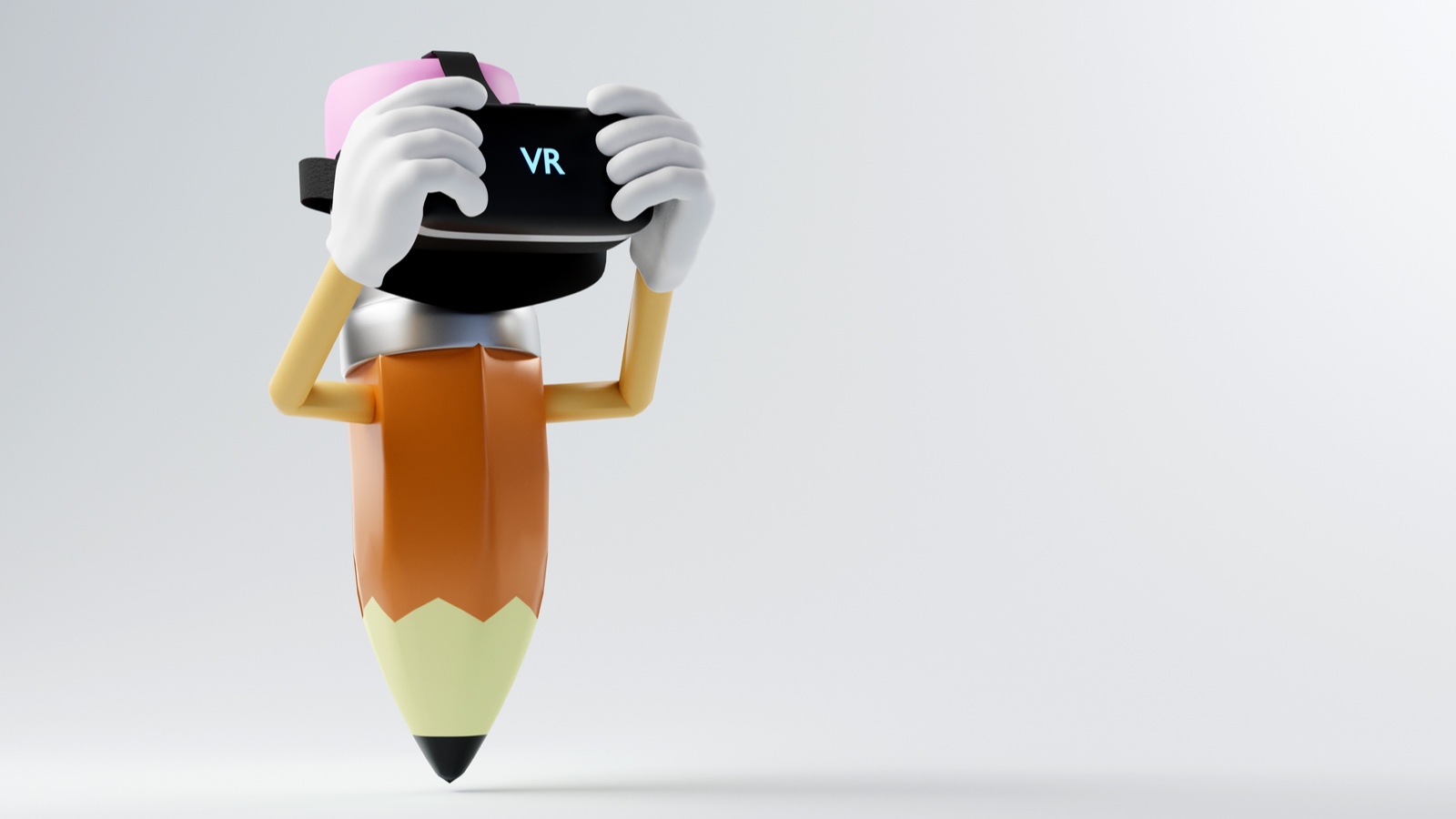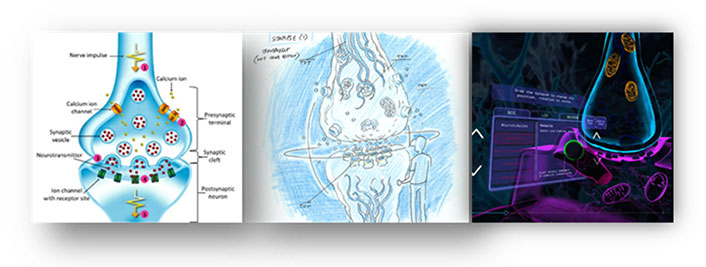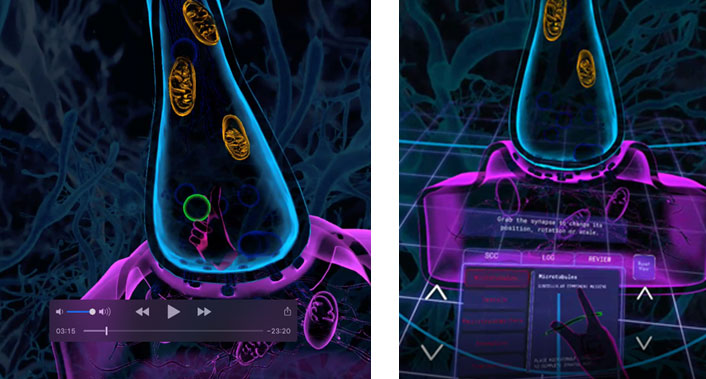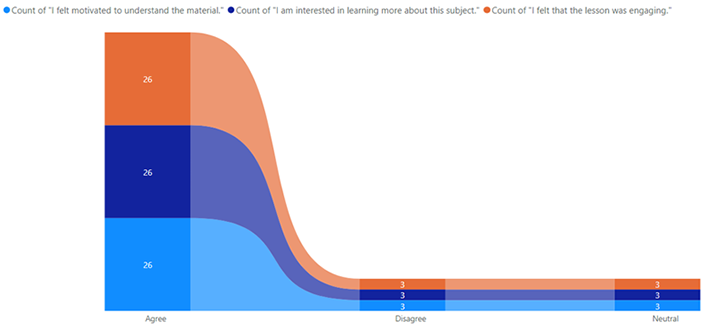Faculty and staff at Southern New Hampshire University piloted virtual reality in an undergraduate psychology course to see if it can be an effective pedagogical tool.

In early 2020, just before the onset of the coronavirus pandemic in the United States, Southern New Hampshire University (SNHU) faculty, staff, and students caught a glimpse of the classroom of the future. To better understand the feasibility of using virtual reality (VR) as an educational tool, a campus multipurpose room was transformed into something from another time. Posters taped to the doors announced to passersby that "immersive learning" was in progress. Blue painter's tape marked off ten six-foot by six-foot squares for VR stations. Staff members wearing Oculus Quest headsets drew invisible boundary markers with hand controllers to create play zones while undergraduate psychology students trickled in for class, wondering what that day's session had in store for them after weeks of anticipation.
During their first day of using VR in the classroom, students likely did not know about the weeks of exciting, interdisciplinary collaboration between teams of educators, IT specialists, programmers, and developers that went on to make these new virtual experiences possible. This shared effort between educators and people in industry to use VR technology to fulfill university course outcomes was, to our knowledge, relatively new to higher education. Nicholas Burbules defines VR as "a computer-mediated simulation that is three-dimensional, multisensory, and interactive, so that the user's experience is 'as if' inhabiting and acting within an external environment."Footnote1
This feasibility study was part of a larger initiative in which a total of three VR experiences were created for an SNHU biopsychology course. This initiative was a collaboration between psychology faculty member Peter Frost and members of SNHU Labs, the university's research and development unit. The three VR experiences, collectively referred to as Synapse VR, were created by our team in conjunction with a global production studio called Unit9 (see figure 1).

Meeting the Learning Needs of Gen Z and Beyond
While this study was conducted with current SNHU undergraduates, our team aimed to understand the implications of immersive learning for both today's students and future learners.
Today's traditional college-age learners between the ages of eighteen and twenty-two are members of Generation Z, also known as Gen Z. The oldest members of Gen Z entered college in 2015. As Gen Z students mature, so will their expectations for learning experiences that give them the knowledge, skills, and abilities that are essential to thrive in the future labor market. Having grown up with many of the same expectations for their learning experiences as Gen Z, students from Generation Alpha (the generational cohort that succeeds Gen Z) are entering their college years now.
Extended reality (XR), immersive technologies encompassing VR as well as augmented reality, holds promise as a learning tool to meet Gen Z and beyond on their own terms. Within XR, SNHU has focused on VR as a vehicle for delivering high-quality instructional experiences. Given Gen Z's documented love for gaming and their desire for higher education to equip them with problem-solving and practical skills, VR provides a confluence of experiential learning and engagement.Footnote2
Current market demand for immersive learning in K-12 can shed light on the expectations of future learners for colleges and universities. It is important to note that while only 5 percent of K-12 teachers around the world surveyed in 2016 by Project Tomorrow use augmented reality (AR) or VR tools, Futuresource Consulting predicted in 2018 that 15 percent of US schools would have a VR class kit by 2021.Footnote3 Higher education must look at VR through the lens of learning science to realize its potential as a teaching and learning tool.
By 2030, we predict that learners will expect high-quality XR experiences. To meet the expectations of future learners, SNHU will continue to explore ways to integrate this technology into existing and future courses in ways that positively impact learners.
Implementing VR in the College Classroom
Between spring 2019 and winter 2020, our team designed and developed the VR app and then implemented it in the classroom. During the design and development phase, stakeholders carefully reviewed the existing biopsychology curriculum to identify opportunities where VR could best serve the needs of learners. Eventually, the collaborators created three separate educational VR experiences, each focusing on a different aspect of how information spreads within and between neurons and how these processes influence human behavior. With each iteration of the VR experience, from prototype to VR app, SNHU Labs conducted user testing to understand the needs of learners.
In February 2020, our team implemented two Synapse VR experiences with undergraduate students. The first experience focused on neural transmission, and the second focused on neural conduction. Our team implemented the experiences with the end goal in mind, poring over the existing syllabus to identify opportunities to support course objectives with student engagement in VR. Our team determined that focusing on areas where highly abstract concepts, such as subcellular processes, that are hard for students to imagine and tend to take extra time in class for discussion would be best.
The resulting experiences allowed learners to engage with the anatomical structures as well as the steps of two related biopsychological processes: neural transmission and conduction. As described in the following two sections, students were challenged to solve problems and take a systems approach to facilitate the neural transmission and conduction processes. By design, these experiences required students to take an active role rather than a passive one, incorporating moments of productive struggle that make learning stick.
The two VR experiences were intended to help students achieve the following two course outcomes:
- Understand the interplay between neural communication, neural circuits, and psychological activity and behavior
- Apply biopsychology to other areas of psychology (e.g., mental health, addiction, and development) and disciplines outside of psychology (e.g., economics, law, computer science, artificial intelligence, and education)
Neural Transmission (the Chemical Communication Between Neurons)
Students started the first Synapse VR experience by interacting with a 3D brain model before journeying to more microscopic levels within the brain where they could see and interact with the neurochemicals and neural structures involved in communication between neurons. As they progressed through the experience, students could view representations of neural structures and control the various parts of the neuron to see what those parts do. They were then tasked with locating certain structures and regulating their functions to solve problems with neural signaling. Students could walk around the structures to see them from various angles. They also used a virtual tablet that allowed them to identify the neural structures they encountered. The structures, though microscopic, could be scaled up by students to a relatively large, more viewable size (see figures 2 and 3).


Neural Conduction (the Spread of an Electrical Signal Within a Neuron)
The second Synapse VR experience gave students a chance to tinker with the steps necessary for a neuron to fire an electrical charge. Neural conduction can be a difficult concept to teach traditionally, but with VR, students can see a neuron at a much larger scale—almost the size of a house—and view all the processes that occur with ions and gates at a pace they control. Students were able to set the pace of neural firing with a ring that wraps around the axon of a neuron. They were tasked with adding critical components to the neuron that help with various stages of neural firing. If they were able to move the signal along the neuron, the neuron sent a signal to numerous other neurons, causing the skybox display to show these firings occurring all around the student (see figure 4).

Designing for the Classroom of the Future
We designed Synapse VR with the classroom of the future in mind. In order to truly understand the realities of implementing immersive learning experiences in a face-to-face classroom, designing the implementation of the two VR experiences with as much care as the creation of the app itself was essential.
Students were oriented to VR technology by completing the First Steps tutorial that comes with the Oculus Quest. First Steps is a user-friendly and entertaining tutorial that shows users how to use the technology and various functions of the VR user controllers. This tutorial was necessary for many of our students as we found most of them had not experienced VR previously.
During the feasibility study, each VR experience was the focus of a single class session with nearly twenty students in attendance. Our team incorporated VR with course content in two different ways to explore the use of the technology as a tool to spark students' interest before concepts were introduced and as a tool to explore in more depth concepts that had already been introduced. The first experience followed the lecture on neural transmission. The second experience preceded the lecture on neural conduction.
To help students learn to use the technology, they worked in pairs with one Oculus Quest headset per pair. Students took turns playing the role of "explorer" and "guide" in the VR space. Each pair was provided with a guidebook to prompt each phase of the simulation. The guide used the guidebook to instruct the explorer. Both students attempted to answer questions along the way to keep them focused on the essential aspects of each stage of the VR experience. The guidebook was available to help the explorer and guide troubleshoot when necessary.
Evaluating Students' Responses to VR
The primary objective of the feasibility study was to answer the question: When carefully designed and implemented, does the use of AR/VR reliably improve student enthusiasm for course content? As we think ahead to wider adoption of VR, understanding how real students respond to VR as an educational tool is important.
While the education sector has seen greater use of technologies like VR, relatively few studies have explored how it has affected learning and motivation.Footnote4 Some studies have shown that although retention is not different between traditional learning and virtual reality, VR groups tend to transfer learning on problem-solving tests to a greater extent (that is, skills tend to transfer to new situations).Footnote5
Our preliminary research shows that immersive VR learning experiences can spark student interest, motivation, and engagement. After participating in each VR experience, students responded to a survey containing questions about their reactions to the use of VR in the classroom using a measure of interest, motivation, and engagement from a recent study of immersive learning by Jocelyn Parong and Richard Mayer.Footnote6 Between the two classes, a total of thirty-two student survey responses were received. Eighty-one percent of the student responses agreed with statements about feeling motivated to understand the material treated in VR, being interested in learning more about neural communication, and finding the lessons engaging overall (see figure 5).

Students expressed enthusiasm for learning with VR, with 87 percent of all responses indicating that the VR lesson was useful, enjoyable, and something students would like to learn with in the future (see figure 6).

These preliminary reactions from students are encouraging and suggest that immersive learning experiences may be able to support motivation, interest, and engagement in learning.
Lessons Learned
Our glimpse into the classroom of the future generated three insights that will guide future exploration of VR for SNHU and may be of interest to other college and university educators seeking to bring immersive learning experiences to their students:
- Investigate collaborative learning models for VR. Not all classrooms will have a full class set of VR headsets. This is an important consideration for the classroom dynamic when immersive learning is implemented. One approach to collaborative learning may be to pair students as "guides" and "explorers" as we did in our feasibility study; however, students who began as guides ended up spending more time outside of VR than those who began as explorers. One student noted the disparity in engagement with those who spent time outside of VR, reflecting, "The person not inside the VR has a very boring job. They can't really keep up with what the person in VR is experiencing, and the booklet is too simple." Further experimentation is needed to understand how to maximize learning with VR when students need to take turns using the equipment.
- Retool the VR orientation processes. How students are trained on the technology impacts the overall learner experience. Most students were relatively inexperienced with VR and took longer to get acquainted with the technology. We believe it is essential to provide students with access to more dedicated training on the technology and time to get comfortable using VR by playing games to learn the mechanics. Combining VR orientation during class time took time away from the main VR experience. We recommend requiring a brief VR studio session prior to the start of the term in which students can sign up for time slots to get trained on the technology and play a game or two before using VR as an educational tool.
- Invite input from learners early and often. College and university educators who are seeking to incorporate VR experiences in their classrooms can benefit from the gaming expertise of their Gen Z students. These learners are savvy consumers of gaming experiences and eager to offer feedback. In their survey responses, many students thoughtfully noted opportunities to improve VR mechanics and streamline logistics. As more immersive learning experiences are developed, it is vital to involve students in the design and invite them to provide feedback on iterative prototypes and co-design when possible.
Overall, this project expanded collaboration across disciplines at SNHU, challenged our team to ground the experiences in learning outcomes, encouraged thinking about teaching and content delivery in new ways, and built up a new toolset based on our emerging understanding of the possibilities in VR. We answered our original research question and generated some new ones. We are eager to continue learning about the potential of VR to help our university prepare for the future of learning.
Notes
- Nicholas C. Burbules, "Rethinking the Virtual," in The International Handbook of Virtual Learning Environments, eds. Joel Weiss, Jason Nolan, Jeremy Hunsinger, and Peter Trifonas (Dordrecht: Springer, 2006), 37–48. Jump back to footnote 1 in the text.
- SNHU and Generation Z, unpublished research report, (Stockholm, Sweden, and Manchester, NH: Kairos Future and Southern New Hampshire University, 2019). Jump back to footnote 2 in the text.
- Games and Learning: Immersive Learning Market Overview and Sector Analysis, unpublished research report, (Manchester, NH: Southern New Hampshire University, 2019); "Augmented and Virtual Reality in K-12 Education: Current Status and Aspirations," [https://tomorrow.org/speakup/speak-up-2016-augmented-and-virtual-reality-in-k12-education-april-2017.html] infographic, Project Tomorrow, Speak Up 2016; Michele Molnar, "Virtual Reality 'Class Kits' Expected to Gain Foothold in U.S. Schools," EdWeek Market Brief, January 26, 2018. Jump back to footnote 3 in the text.
- Guido Makransky and Gustav Bøg Petersen, "Investigating the Process of Learning with Desktop Virtual Reality: A Structural Equation Modeling Approach," Computers & Education 134, no. 1 (June 2019): 15–30. Jump back to footnote 4 in the text.
- Guido Makransky, Stefan Borre‐Gude, and Richard E. Mayer, "Motivational and Cognitive Benefits of Training in Immersive Virtual Reality Based on Multiple Assessments," Journal of Computer Assisted Learning 35, no. 6 (July 2019): 691–707. Jump back to footnote 5 in the text.
- Jocelyn Parong and Richard Mayer, "Learning Science in Immersive Virtual Reality," Journal of Educational Psychology 110, no. 6 (August 2018): 785–797. Jump back to footnote 6 in the text.
Cat Flynn is a Director of Learning Science at Southern New Hampshire University.
Peter Frost is a Professor of Psychology at Southern New Hampshire University.
© 2021 Cat Flynn and Peter Frost. The text of this work is licensed under a Creative Commons BY-NC-ND 4.0 International License.
